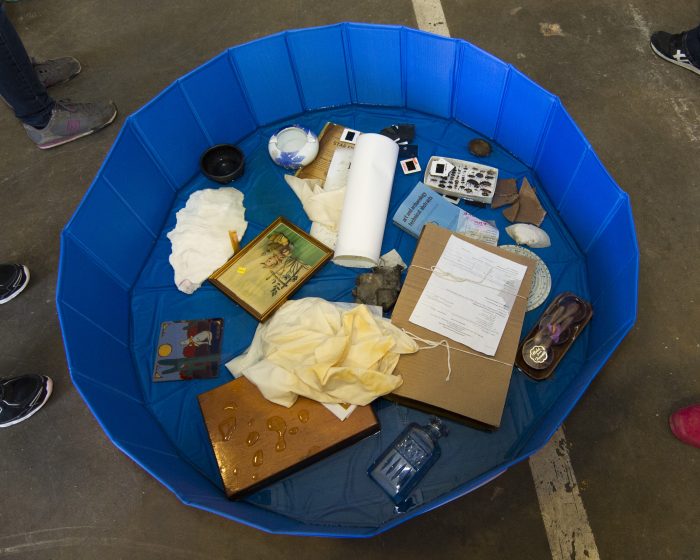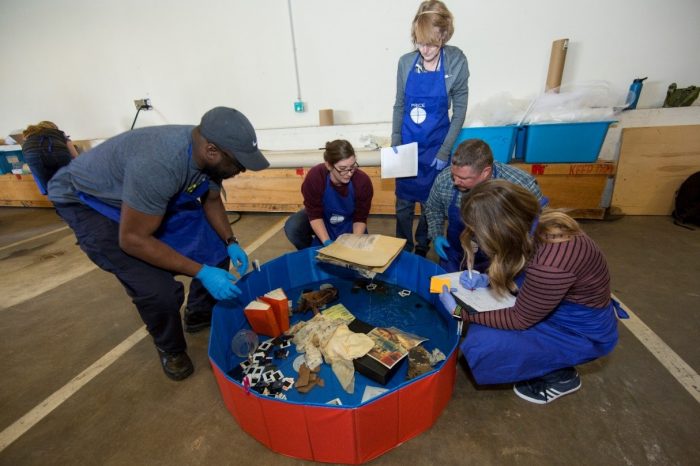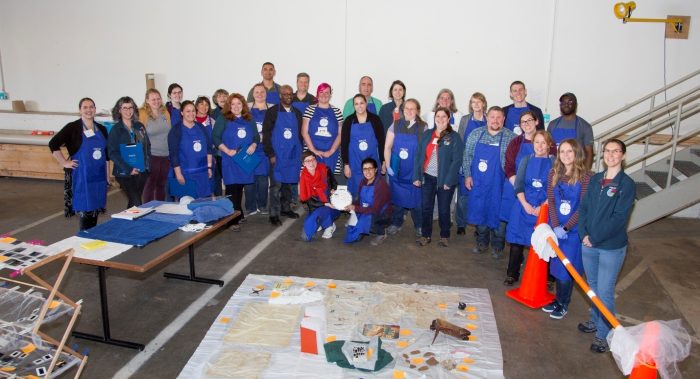Water, water, everywhere can cause more damage than you think
It may be a truism that Washington was built in a swamp, but humidity, water damage and mold from floods, broken pipes and our swampy summers are real threats to the collections in our care. Earlier this year, the National Collections Program helped organize a training program designed to help staff keep their heads—and our national treasures—above water.

A pool of stunt-double artifacts. (No actual artifacts were harmed in the making of this story.) (Photo by Michael Barnes)
The month of May is internationally set aside for doing one small thing for collections emergency preparedness. This year the National Collections Program and the Preparedness and Response in Collections Emergencies (PRICE) team organized and led the second annual MayDay Training opportunity for staff from across the Institution. Twenty staff members were invited to participate in a two-day lecture and hands-on learning session on salvaging water-damaged collections at Pennsy Drive on April 25 and 26. The participants represented 15 different Smithsonian units and multiple disciplines, including security, industrial hygiene, fire protection, engineering, facilities, emergency management, conservation, collections management, registration, archives, and libraries. A three-hour orientation was held in late March to brief the participants on what to expect at the April training and to provide basic object handling instructions using a variety of stunt-double artifacts.

Training participants conduct triage on water-damaged items representing museum collections. (Photo by Michael Barnes)
The goal of this training is to bring together staff from various disciplines to learn with each other about how various collection materials react to and are affected by water. On the first training day, the class covered collections emergency safety, procedures for re-entering an affected space, risk and damage assessment, drying techniques, and dealing with mold. The National Museum of African American History and Culture supported the training by allowing the class to use their storage space for scenario exercises designed to establish salvage priorities and develop teams. The class also learned about specific salvage techniques for the materials most commonly encountered in collections, including textiles; books; archival materials such as photographs, audio-visual and digital records, and works on paper; wood, ceramics, glass, metal, paintings, and natural history materials.
The second day of training included presentations on the role of the Office of Emergency Management and how to work with recovery companies and vendors. In both days of training, expertise shared by colleagues from the Smithsonian American Art Museum, Smithsonian Cultural Rescue Initiative, and Smithsonian Facilities helped to frame the discussions on specific Smithsonian experiences and resources. The PRICE training team developed new guidelines for working with recovery vendors and managing emergency documentation. The class worked in teams which helped them to think creatively and collaboratively on what information is the most critical to record and how to effectively communicate that to the whole team.
All of the presentations and discussions led up to the big event—physically recovering stunt-double-artifacts from pools of water, documenting their recovery and beginning triage and drying. The salvage session teams showed effective communication, coordination, initiative, and creativity—exactly what is needed during a collections emergency and subsequent recovery.

Staff from 15 units participated in the second annual PRICE MayDay Training in April. (Photo by Michael Barnes)
*Only stunt-double artifacts were used during this training. No accessioned items are ever used for PRICE training events.*
Special thanks to the PRICE Team (Kerry Button, Cathy Hawks, Becky Kaczkowski, Becca Kennedy, Nora Lockshin, Sam Snell and Katie Wagner), MayDay Planning team (Stacy Bowe, Alyx LeBlanc, Lisa Palmer, and Allison Schuette), Amber Kerr, Ramon Davis, Bill Mangum, and Bill Tompkins.
Allaire Stritzinger is an intern with the National Collections Program and is currently pursuing a master’s degree in museum studies with an emphasis on collections management and administrative policy. Samantha Snell is a collections management specialist with the Smithsonian’s National Collection Program.
Posted: 16 July 2018






